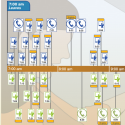Menu

Morgan Smith
Lessons from ABOTA Masters in Trial: Cutting-Edge Techniques for 21st Century Evidentiary Issues
 This post is by Martha Pettit
This post is by Martha Pettit
Design & Administration Associate
We are in the midst of a big data explosion. E-discovery, metadata, black box data, cell phone records, social media … the list goes on and on. Last Friday at the American Board of Trial Advocates (ABOTA) Masters in Trial in San Francisco, I learned how trial lawyers are navigating and harnessing this brave new world of big data (or as they refer to it, evidence) to their advantage with demonstrative aids and expert testimonies. As a bona fide data visualization geek and ex-debater, my day in a room full of lawyers talking data was quite a treat.
Some of the key takeaways from the ABOTA masters that can benefit all trial attorneys:
- Make sure you have the right technical set-up to show off all that evidence.
Some of the lawyers used iPads and Keynote, some used Trial Director and some used Powerpoint. My role for the day was to shadow and assist attorney Rob Foss, who handled all the trial technology, since Cogent Legal provided assistance in legal graphics and trial tech for the event. Rob did a great job navigating the various on-the-fly requests to add a slide or exhibit just moments before a presentation. The importance of always having evidence available on a slide or physical presentation board for the jury was mentioned by multiple presenters.
- Getting evidence in front of a jury requires serious due diligence.
I was very interested in some of the arguments that were used to keep visuals of evidence out of court. For example, Mary E. Alexander, in a mock trial with Robert M. Peterson, argued that the color red used in a graphic was too inflammatory and grounds to exclude a piece of evidence. She also raised the issue of a graphic that was not scaled correctly. Also, the difference between an animation and a simulation is a very importance distinction in court, and was discussed extensively by Doris Cheng and Chris Beeman.
- Use visuals to emphasize key argument themes.
As a visual designer, it warmed my heart to hear the presenters repeatedly mention the importance of visuals to their case. Every single attorney who presented used some type of visual aid to make their case. Kathleen M. Lucas even listed “no visuals” as one of her pet peeves. The quality of the visuals will also affect how your case is perceived by the jury. Just as you would be wary to buy a product from a website with garish colors, bad typography and confusing layout, so too will a jury be wary of a visual that looks less than professional.
The above takeaways are just the tip of the iceberg when it comes to the topics covered at the Masters in Trial. As the Internet of Things becomes more and more prevalent in our lives, the use of compelling data visualizations in the courtroom will become an essential element to make sense of large and complex data sets that are generated daily via computers in our phones, cars and more. In addition, the use of 3D animations and interactive graphics to vividly portray expert opinions and build complex timelines will become more prevalent as studies (such as this one by Ken Broda-Bahm) continue to prove the effectiveness of visual aids in the courtroom, and the cost and time to produce and display such graphics is no longer a barrier due to technological advances.
If you’d like to receive updates from this blog, please click to subscribe by email.
Recent Posts
- Proper Digital Discovery, Part IV: Using Drones in Modern Litigation
- Proper Digital Discovery, Part III: Using Digital Imagery in Modern Litigation
- Proper Digital Discovery, Part II: Electronic Measuring Data
- How to Obtain Proper Digital Discovery, Part I: Photography
- California Courts – Latest Updates
